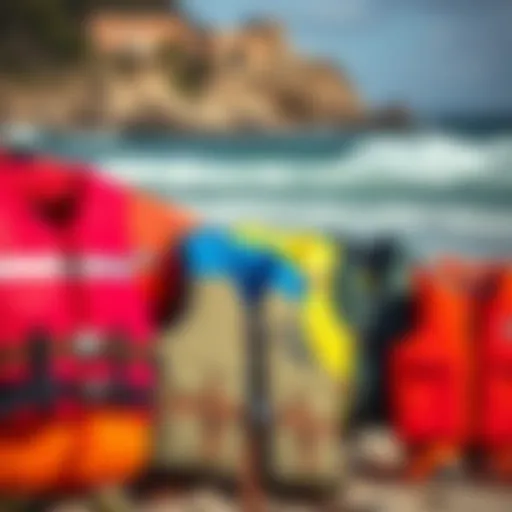Discovering the Beauty of Glass Beach in California
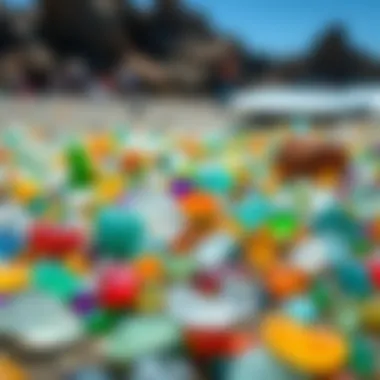
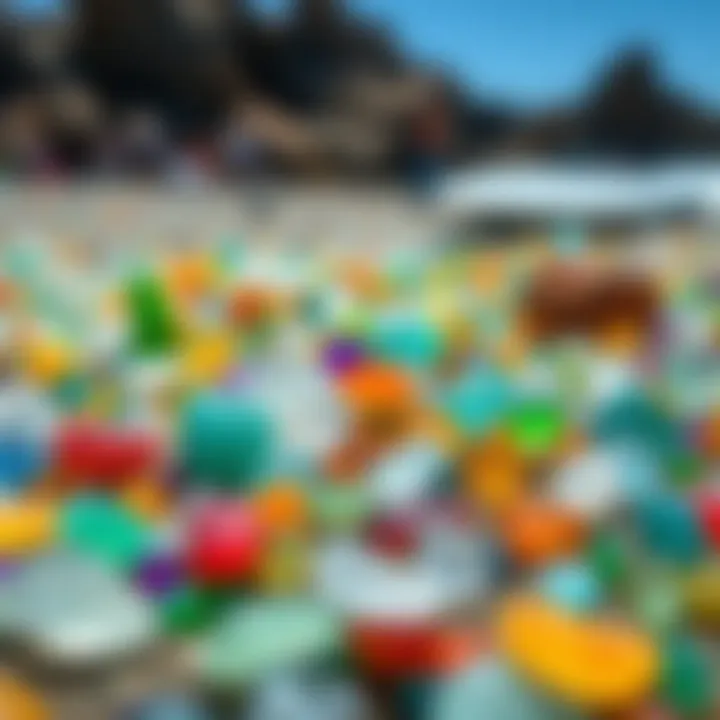
Intro
Nestled along the rugged coastline of Fort Bragg, California, Glass Beach boasts a mesmerizing blend of natural beauty and human history. The shoreline is not just a feast for the eyes, with its glimmering sea glass, but it also carries tales of resilience and transformation. Once a wasteland of discarded refuse, it has evolved into a coveted destination for travelers, artists, and environmentalists alike. Here, the ocean’s powerful currents have polished the remnants of glass into colorful gems, creating a tapestry that tells a story of both nature and human intervention.
In this article, we will explore the various elements that contribute to the allure of Glass Beach. From its origin as a landfill to its current status as an ecological wonder and a cultural landmark, we aim to provide a comprehensive guide. We’ll delve into its unique ecosystem, the ongoing preservation efforts, and the myriad ways visitors can enjoy this beautiful spot while respecting its fragile environment.
Intro to Glass Beach
Glass Beach remains a remarkable location, feeding curiosity and wonder among surfers, travelers, and outdoor lovers. Its vibrant collection of worn, colorful sea glass offers a unique glimpse into nature’s artistry blended with a touch of human history. This section is critical for readers, as it sets the stage for understanding the environmental and cultural significance of these striking coastal landscapes.
Defining Glass Beach
Glass Beach is not merely an ordinary shore; it's where the remnants of glass bottles and jars, once discarded, have been transformed by the relentless motion of the ocean. Over time, the sharp edges smooth out, creating soft, glimmering pebbles scattered across the sand. Now, visitors can witness these beautiful treasures nestled among the usual sandy shores. The most famed Glass Beach is in Fort Bragg, California, significant for its rich past tied to waste disposal practices and environmental resilience. Each small piece tells a story, both of neglect and renewal.
Overview of Coastal Attractions
For those drawn to nature's wonders, Glass Beach is part of a broader tapestry of coastal attractions.
- Ecological Diversity: The regions surrounding these beaches are often teeming with diverse marine life, from curious tidepools to dancing seaweed.
- Scenic Beauty: The sunsets at Glass Beach are nothing short of spectacular; colors morphing from deep oranges to soft lavenders as sun dips below the horizon.
- Community Engagement: Nearby towns often host festivals and events celebrating art, music, and the environment, giving a vibrant community spirit to the area.
Travelers will find activities that cater to various interests—from leisurely beachcombing, where one can sift through the sand for hidden gems, to photography that captures the stunning landscape and intriguing sea life.
In summary, this introduction not only highlights the unique characteristics of Glass Beach but also emphasizes its role within the wider setting of coastal attractions. Visitors don’t merely come to gaze at glass; they explore a rich ecosystem, partake in gritty, spontaneous adventures, and soak in the local culture that thrives in symbiosis with this captivating coastal spectacle.
Geographical Locations of Glass Beach
The geographical locations of Glass Beach provide a foundation that underpins the entire allure of this unique coastal phenomenon. These areas are not just scattered stretches of sand but serve as cherished destinations where nature’s artwork and human history intertwine. The significance of these locations includes their ecological importance, the behaviors and adaptations of local wildlife, and the way they draw travelers from all walks of life.
Glass Beach in Fort Bragg, California
Fort Bragg's Glass Beach is perhaps the most renowned of all the glass beaches. Nestled along California's rugged coastline, this site’s transformation from a dump to a picturesque seaside destination tells a compelling story. Over decades, ocean waves have smoothed and polished glass shards left behind, resulting in a sparkling shoreline that attracts beachcombers and photographers alike. Walkers can usually be seen sifting through the colorful pieces, each one reflecting a bit of sunlight like a jewel embedded in the sand.
Aesthetically, the array of colors – greens, browns, and even blues and whites – contributes to the area's appeal making it not just a beach, but a treasure trove of visual delight. Moreover, the beach affords visitors remarkable views of the Pacific Ocean, where waves crash against the cliffs and the salt air invades the senses. For outdoor enthusiasts, Glass Beach is a place where relaxation meets adventure.
Other Notable Glass Beaches
Glass Beach in Kauai
Kauai's Glass Beach offers a different flavor of beach experience. Nestled on the north shore of this Hawaiian island, it is mostly known for its breathtaking vistas. Unlike Fort Bragg, the glass here is considerably less abundant, making it a less favorable spot for beachcombers. However, it is still an alluring site, primarily due to the stunning rock formations and vibrant marine life that can be observed in the surrounding waters.
A highlight of Kauai’s Glass Beach is the unique interplay between the rugged landscape and the calmness of the coral reef. This conjunction allows for tranquil snorkeling experiences. While one isn’t likely to find a bounty of glass at this beach, the natural beauty envelops visitors, offering a sense of peace that is often sought in tropical getaways.
Glass Beach in Wakkanai
While Fort Bragg might steal the limelight, Glass Beach in Wakkanai, Japan, is often seen as a hidden gem. Known for its extraordinarily smooth glass pieces, this beach serves as an intriguing example of the intersection of culture and natural processes. The local legends about the glass suggest that it’s tied deeply to the fishermen and their stories.
Wakkanai’s Glass Beach is characterized by its vast stretch of shoreline, allowing one to enjoy long walks while observing the exceptionally vivid underwater life. The pristine conditions present here can sometimes reveal sea creatures not seen in more touristic locations. Thus, for those who seek a closer connection with nature, Wakkanai holds hidden delights that celebrate both biodiversity and rich cultural narratives.
Unused Glass Shores Worldwide
The concept of unused glass shores brings to light places that have not yet benefited from human touch, leaving behind shores where nature reigns supreme. Some areas globally —like certain parts of the Caribbean or Mediterranean — feature shores littered with fragments of glass amid natural rocky terrains. These unexplored sites offer an unforgettable experience for eco-tourists who wish to witness the raw beauty of glass in its untamed environment.
However, reaching these untouched shores can be a trek, often involving off-the-beaten-path exploration. Some individuals might find the lack of amenities challenging, while others relish the freedom of a pristine, less-commercialized experience.
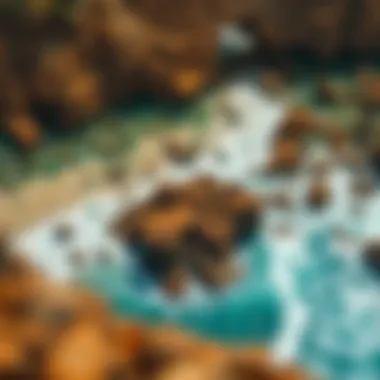
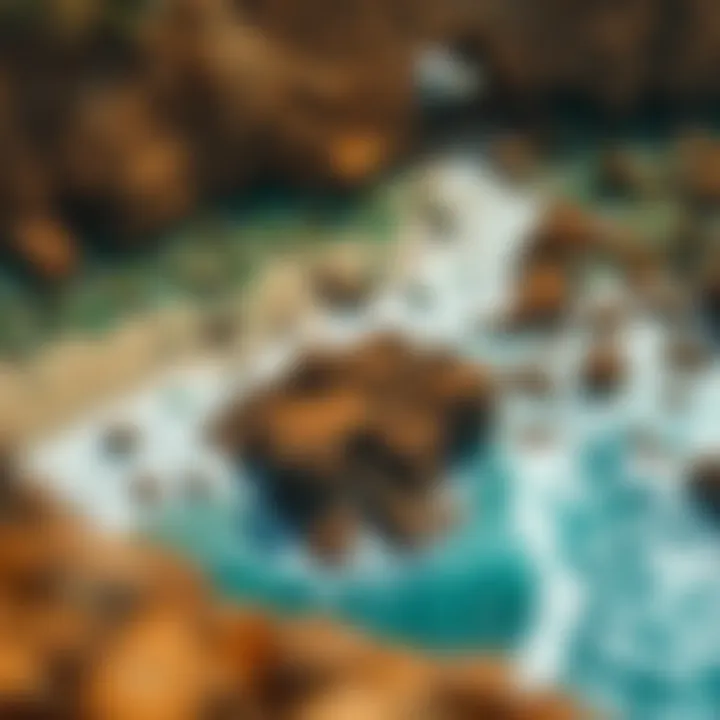
"Each glass beach tells a story, reflecting not just nature's artistry, but humanity's history too. Each fragment is a piece of our past, washed ashore and transformed by time."
In exploring these geographical locations of glass beaches, travelers can appreciate the blend of history, natural beauty, and ecological richness that these unique sites bring to the table. Whether one seeks the vibrant sands of Fort Bragg or the serene shores of Wakkanai, every glass beach has a distinct narrative to share.
The History of Glass Beach
Understanding the history of Glass Beach is crucial since it not only sheds light on the natural transformation of this unique coastal environment but also reveals the intricate relationship between humans and nature. The past of Glass Beach, primarily located in Fort Bragg, California, reflects a compelling narrative of waste, resilience, and regeneration. As we explore its origins and cultural significance over time, we observe how the coastal landscape serves as a canvas for both natural forces and human activity, shaping today’s vibrant seascape.
Origins of the Glass Beach Phenomenon
The Glass Beach phenomenon began in the 20th century, when Fort Bragg residents disposed of their refuse, including glass, onto the shoreline. The ocean acted as both a custodian and a transformative force—over the years, relentless waves broke down the glass, smoothing the sharp edges and turning shards into colorful pebbles. This unintentional art project arose from neglect, evolving from a trash site to a celebrated treasure.
During the early part of the 20th century, it was not uncommon to see people leaving behind broken bottles and jars at the beach. The currents and tides took care of these remnants, and locals soon recognized the beauty within this seemingly neglected landscape. Over the decades, the efforts of nature merged with the remnants of human activity, resulting in a dazzling array of sea glass in blues, greens, and ambers that now beckons visitors from all corners of the earth.
"What once was waste is now a mosaic of history, revealing both the folly and creativity of humankind."
Cultural Significance Over Time
The cultural journey of Glass Beach has seen it transitioning from an overlooked dump to a cherished natural wonder. The tide shifted not just because of the changing perception of waste but also due to the community's growing appreciation for its beauty. As awareness of environmental issues grew, so did the understanding that places like Glass Beach could be both stunning and fragile.
In the late 20th century, as the beach gained popularity, various social movements began advocating for its preservation. Local artists started organizing community clean-up initiatives, transforming the area into a vibrant hub for artists, photographers, and environmentalists alike. The blending of creative expression with ecological activism made Glass Beach not just a place to visit but a source of inspiration for many.
Moreover, the beach reflects changing attitudes toward sustainability. It serves as a poignant reminder of the repercussions of littering while simultaneously illustrating the potential for regeneration and beauty from human error. Visitors now come to connect with the history of Glass Beach and take part in its ongoing narrative.
In summary, understanding the history of Glass Beach brings together the threads of waste, beauty, and sustainability, weaving a rich tapestry that enriches not only our appreciation for nature but also our responsibility towards it. A visit here becomes more than just sightseeing; it transforms into a pilgrimage of learning and reflection.
Ecological Impact of Glass Beaches
The ecological ramifications of Glass Beaches are significant, as they serve as unique ecosystems that exhibit a delicate interplay between nature and human influences. These beaches, often adorned with an array of colorful sea glass, not only attract visitors but also support various forms of wildlife.
To understand the ecological impact of these fascinating locales, it’s essential to examine the roles they play in maintaining biodiversity, as well as the challenges they face from environmental factors.
Biodiversity and Ecosystem Roles
Glass Beaches are not mere attractions for tourists; they are vibrant ecosystems teeming with life. The layers of sea glass create a distinct habitat for numerous marine and coastal species. Here’s a closer look at how these environments contribute to biodiversity:
- Refuges for Wildlife: The smooth, colorful glass pieces mimic natural pebbles, providing hiding spots for small fish and invertebrates. Species like crabs and starfish utilize these habitats to shelter from predators and strong currents.
- Nutrient Cycling: The decomposition of organic matter that accumulates on these beaches, combined with the filtration capabilities of sand and glass, helps in nutrient cycling, essential for the health of the ecosystem.
- Unique Flora: Coastal vegetation often thrives near Glass Beaches. These plants play a crucial role, not only stabilizing the sand but also offering food and habitat for diverse insects and birds.
"The Glass Beach ecosystem reflects a remarkable synthesis of natural renewal and human impact, showcasing both beauty and fragility."
Environmental Challenges
Despite their allure, Glass Beaches battle a multitude of environmental challenges that threaten their ecological integrity. Here are some key concerns:
- Pollution: While the sea glass itself originates from discarded bottles and other glass waste, other forms of pollution continue to affect water quality and marine life. Plastics and chemicals washed ashore can harm the ecosystem.
- Overtourism: As more visitors flock to these scenic spots, pressures mount on the delicate environments. Increased foot traffic can lead to trampling of vegetation and disruption of wildlife habitats.
- Climate Change: Rising sea levels and changing oceanic conditions pose a long-term threat. The erosion of coastal areas and the changing makeup of marine life can alter the Glass Beach ecosystem irreparably.
To counter these challenges, increasing public awareness and encouraging responsible tourism practices are vital. Communities and conservationists are working hand in hand to ensure that Glass Beaches remain a sanctuary for both people and wildlife alike.
Through education and sustainable practices, the beauty of Glass Beaches can continue to inspire future generations while preserving their ecological health.
Preservation Efforts for Glass Beaches
The persistence of environmental degradation has spotlighted the vital need for preservation efforts surrounding unique ecosystems like Glass Beaches. These striking coastal areas, famed for their colorful sea glass, not only attract tourists but also earn their stripes in ecological and historical contexts. It’s crucial to understand that the preservation of Glass Beaches offers a multitude of benefits, ranging from maintaining biodiversity to ensuring that future generations can enjoy their beauty and history.
By encouraging proper conservation practices, local communities can become stewards of these unique shores, fostering a sense of responsibility and pride. Ensuring that the environment thrives means protecting it against pollution and unsustainable human interactions. The idea is not merely to guard a picturesque landscape, but rather to recognize the interconnectedness of these ecosystems with both marine life and cultural heritage.
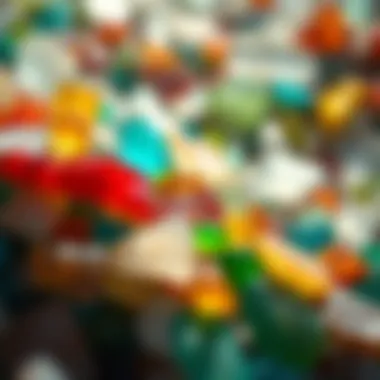
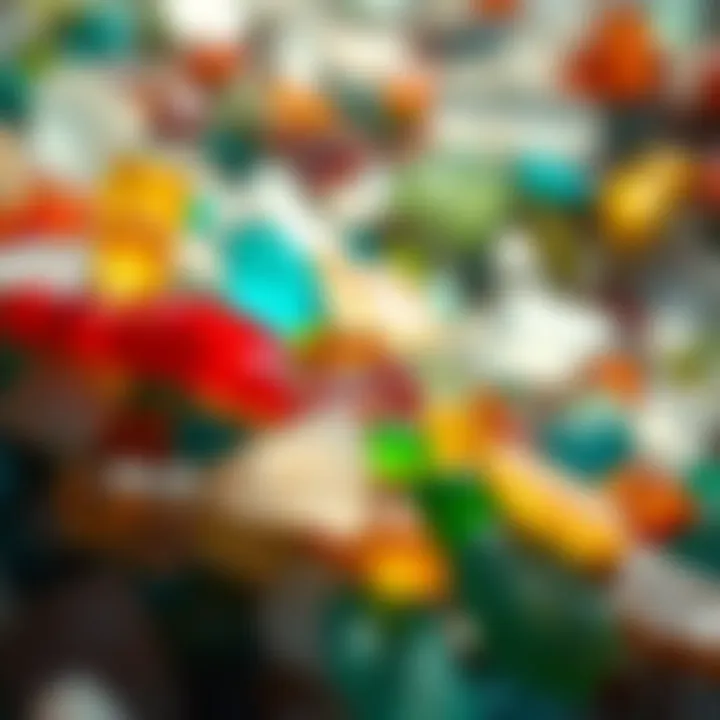
"Preserving our natural wonders, like Glass Beaches, requires a communal effort that involves local communities, authorities, and visitors alike. It's a journey shared in purpose and respect for nature."
Community Involvement in Conservation
Community involvement plays a transformative role in the preservation of Glass Beaches. Residents and local organizations often unite to promote stewardship, engaging in activities designed to clean and protect these stunning coastlines. Regular beach clean-ups and educational campaigns raise awareness about the importance of maintaining these regions. People often come together on weekends, donning their gloves, and picking up litter as they exchange stories of their connections to the beach. This camaraderie not only helps the environment but also strengthens community bonds.
Moreover, educational institutions often collaborate with local groups to hold workshops for children and adults alike, teaching about the ecological importance of Glass Beaches. Programs that involve art, science, and heritage create immersive experiences that are enriching and memorable. Through these efforts, communities are not just advocates of preservation; they are custodians of history and environment, ensuring that the legacy of Glass Beaches endures.
Regulations and Guidelines
Effectively preserving Glass Beaches also hinges on the establishment of regulations and guidelines. Authorities play a pivotal role in implementing policies that govern activities in these areas, such as limiting access during nesting seasons, prohibiting the collection of sea glass, and directing development away from sensitive habitats. Regulations might be seen as restrictions, but when considered carefully, they protect the very essence of what makes Glass Beaches special.
Key guidelines include:
- No littering: Offenders are often subject to fines, making it clear that protecting the natural beauty is paramount.
- Restricted access: Certain areas may be off-limits during specific times to allow wildlife to thrive.
- Educational outreach: Authorities often provide resources to educate visitors on maintaining the integrity of these beaches.
In addition, collaboration with local conservation groups can help improve and enforce these regulations, incorporating input from those who visit regularly. It creates a well-rounded approach that marries ecological health with the desires of the community.
In summary, the preservation of Glass Beaches, through community involvement and solid regulations, is fundamental to safeguarding this spectacular natural wonder. It's a shared responsibility that extends beyond enjoying the scenery; it calls for action to ensure that these coastal treasures remain untouched for future generations.
Traveling to Glass Beach
Traveling to Glass Beach is not just about visiting a stunning location; it’s about experiencing a slice of nature where the land meets the sea, transformed by time and tide. This section emphasizes the essential pathways to accessing this coastal wonder. Understanding how to plan your visit and what to expect can enrich the journey significantly, making the overall experience far more fulfilling.
Planning Your Visit
When considering a trip to Glass Beach, timing and preparation are key. The first step is to decide on the best time of year to visit. The weather along the Northern California coast can be unpredictable. The peak seasons around the summer months generally offer milder weather, which is perfect for beachcombing and photography. However, visiting in the off-peak months could provide a more tranquil experience, as the crowds thin out.
It’s also advisable to scout some resources ahead of time, especially if you are looking for guided tours or want to ensure your visit coincides with local events. Check out sites like TripAdvisor or official tourism pages for Fort Bragg and Mendocino County for the latest information.
Make sure to bring all necessities like water, snacks, sunblock, and a camera—after all, those colorful sea glass treasures won’t photograph themselves!
What to Expect on Arrival
Upon reaching Glass Beach, visitors will find a unique blend of natural beauty and human stories. Being prepared can enhance the adventure.
Local Amenities
Local amenities offer a surprisingly rich experience for visitors. Fort Bragg, the nearest town, hosts a variety of restaurants, shops, and restrooms to cater to tourists. One particularly beneficial aspect is the availability of information centers, where patrons can gather insights on the area's ecological condition and local history.
The quaint coffee shops often provide a chance to mingle with locals who might share hidden gems about the region. Another feature is the proximity of parks where children can burn off some energy before heading to the beach
However, visitors should be mindful that some amenities may have limited hours, particularly during the off-season. Not all establishments may be open, so a little research ahead of time can save heartache.
Parking and Access
Accessing Glass Beach is quite straightforward, with various parking options available nearby. The main parking lot offers convenience, but it can fill up quickly during weekends and holidays. Visitors can also find street parking, although this may require a little extra walking. Plenty of spots are available for those willing to trek a bit more.
A unique characteristic of the area is the scenic view available from the parking lot, providing a picturesque preview of what awaits at Glass Beach. Each visitor should keep in mind that parking regulations are strictly enforced, and violations can result in hefty fines, which no one wants to deal with during a joyful outing.
Safety Measures
Safety should be a top priority while enjoying the beauty of Glass Beach. The ocean waves can be unpredictable, and it’s vital to observe any posted warnings or guidelines. One key feature is the absence of lifeguards, which raises the importance for visitors to be vigilant, especially with little ones in tow.
In any visit, wearing sturdy shoes is recommended, as the glass can sometimes be jagged, and rocky areas could pose a risk for slips. Additionally, packing out whatever you bring can keep the beach preserved for future visitors. It’s all about being responsible while enjoying nature's artistry.


"Preserving the beauty of Glass Beach is not just about witnessing it, but ensuring future generations can enjoy its allure as well."
Visiting Glass Beach is an adventure that transcends a simple day trip; it’s a journey into a world where nature and humanity intertwine. With proper planning and safety measures, the allure of Glass Beach can be experienced fully and responsibly.
Experiences at Glass Beach
Activities Available
Beachcombing
Beachcombing along Glass Beach is a beloved pastime for visitors. This activity allows individuals to sift through the fascinating blend of smooth sea glass, polished by relentless tides. The pleasure of discovery, often akin to treasure hunting, stands out as a primary reason many flock to this site. Beachcombers seek out pieces of glass in myriad colors, and some even turn their finds into unique art or jewelry.
One of the significant qualities of beachcombing is its accessibility; anyone can partake regardless of age or skill level. Moreover, this activity nurtures an appreciation for nature, as each piece of glass tells a fragment of history—be it from an old bottle or a long-forgotten shipwreck.
However, there are subtle disadvantages, such as the seasonal changes that can affect visibility and glass accessibility. During high tides or stormy weather, the beach can become less inviting, and safety becomes a priority
Photography
Photography at Glass Beach presents another enticing opportunity. The interplay of sunlight on the colorful sea glass, combined with the ocean’s waves, creates a picturesque scene that beckons photographers, both amateur and professional. Capturing the beauty of Glass Beach can yield stunning imagery, perfect for sharing on social media or showcasing in exhibitions.
The key aspect that photography provides here is a chance to freeze moments in time. Each click of the shutter immortalizes the diverse hues of glass against the sandy backdrop, often inviting creative interpretations of the landscape. Due to the intricate details of light refraction in the glass, the photographic potential is, quite frankly, boundless.
Despite its advantages, capturing the perfect shot is sometimes challenging, requiring patience and a keen eye for composition, especially as natural light changes throughout the day.
Artistic Inspiration
Artistic inspiration flourishes at Glass Beach due to its enchanting environment. Artists from various disciplines seek this locale, drawing motivation from its striking visuals and organic aesthetics. Whether it's painting, sculpture, or even installation art, the ambiance fuels creativity and reflection.
The unique characteristic of Glass Beach lies in its ability to evoke emotions—creatives often find themselves moved by the stories each piece of glass holds. The serene and unusual setting allows the artist’s mind to wander, leading to innovative expressions.
However, the challenge for some artists is translating their experience into their work. It's one thing to feel inspired and another to convey that feeling in a tangible medium. Artistic blocks can happen, but for those willing to persevere, the rewards are often well worth the struggle.
Personal Reflections of Visitors
Visitor experiences at Glass Beach reveal layers of connection to both nature and one another. Many recount spontaneous moments of joy that emerge from discovering unique pieces or taking in breathtaking views. Common sentiments shared among visitors include a sense of calm brought about by the rhythmic crashing of the waves, which creates a collective memory that transcends individual experiences.
"Standing there, amidst the colors and sounds, I felt a part of something larger."
These reflections emphasize how Glass Beach affects not just one’s visual senses but also invokes personal introspection. Each visit can turn into a memorable journey, inspiring future adventures.
Cohesively, the experiences presented at Glass Beach reinforce its status as a revered attraction, prompting a dialogue about nature, creativity, and personal reflection that extends far beyond the shoreline.
Future of Glass Beaches
The future of Glass Beaches holds a significant place in discussions centered around conservation and sustainable tourism. As natural wonders, Glass Beaches are more than just picturesque landscapes; they serve as crucial ecosystems that require careful stewardship. One might wonder, what steps can we take to ensure these vibrant mosaics of sea glass continue to flourish for generations to come?
Sustainability Considerations
Sustainability goes beyond buzzwords; it embodies a way of life that prioritizes both the environment and the community. Glass Beaches, teeming with unique marine life and delightful artifacts of nature, require sustainable practices to thrive. Here are several key considerations to reflect on:
- Regulated Access: Finding the balance between allowing visitors to experience the beauty while protecting delicate ecosystems is vital. Limiting the number of visitors during peak seasons can help alleviate the pressure on these areas.
- Waste Management: Initiatives aimed at reducing littering and promoting recycling can greatly improve the health of these beaches. For instance, local organizations may set up informative campaigns on waste disposal or even provide incentives for clean-up enthusiasts.
- Community Engagement: Actively involving local residents in conservation efforts not only boosts morale but also creates a sense of ownership over these natural marvels.
- Monitoring and Research: Continuous study of the ecological impact and the quality of the sea glass is essential. This data can guide future policies and management strategies, ensuring that any environmental changes can be addressed swiftly.
"Sustainable practices today lead to a legacy of beauty for tomorrow."
Emerging Trends in Coastal Attractions
As society evolves, so too do the ways we experience coastal attractions like Glass Beaches. Here are some trends that are shaping the future of these captivating locales:
- Eco-Tourism: There's a growing inclination towards eco-friendly travel. Visitors are increasingly seeking experiences that go hand-in-hand with environmental stewardship. Glass Beaches may find themselves at the forefront of this movement, attracting those who wish to learn how to contribute positively to such environments.
- Technological Integration: Digital apps and platforms are being developed to enhance visitor engagement. Imagine an app that offers information about the types of sea glass found on the beach, or alerts visitors to current conservation events—an incredible way for tech-savvy travelers to connect with nature.
- Artisan Collaborations: Local artists and craftsmen are capitalizing on the beauty of Glass Beaches by creating artwork inspired by the glass itself. This not only promotes the beauty of the beach but also contributes to the local economy and encourages cultural exchange.
- Education Initiatives: An increased focus on educational programs, particularly targeting younger audiences, can enhance awareness about the importance of these beaches. Schools may organize field trips, allowing students to engage with natural science firsthand.
As we peer into the future, Glass Beaches stand as a testament to nature's resilience and beauty. By fostering sustainable practices and embracing new trends, we can ensure that future generations will marvel at these miraculous beaches, much like we do today.



